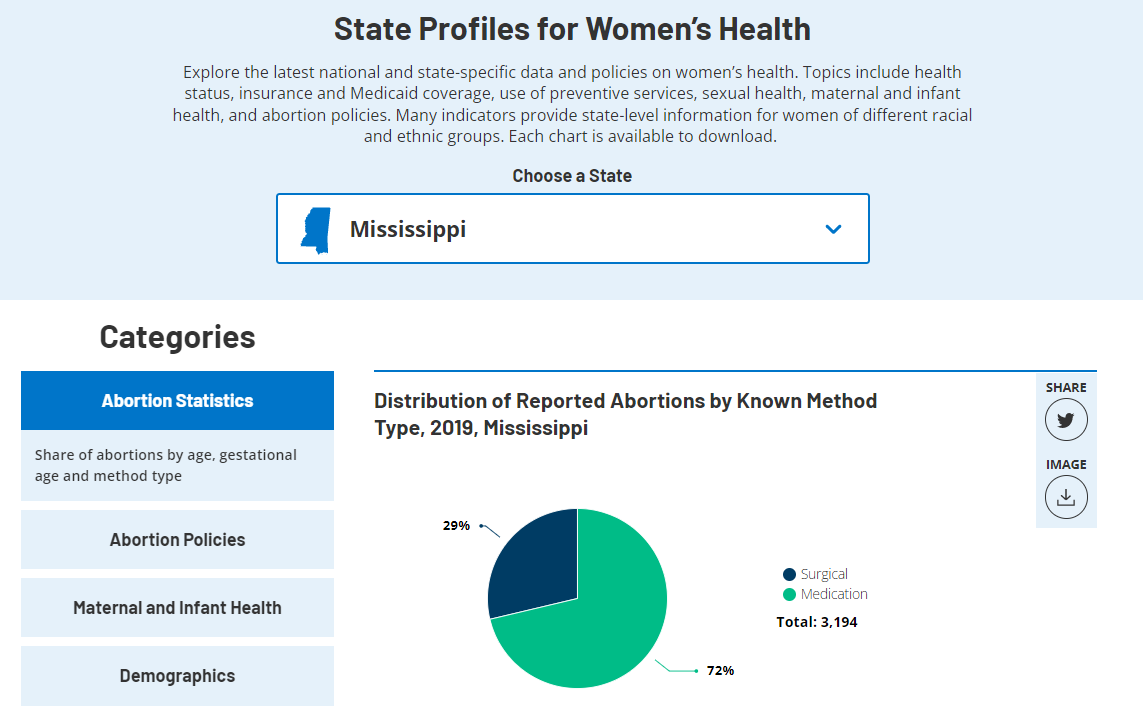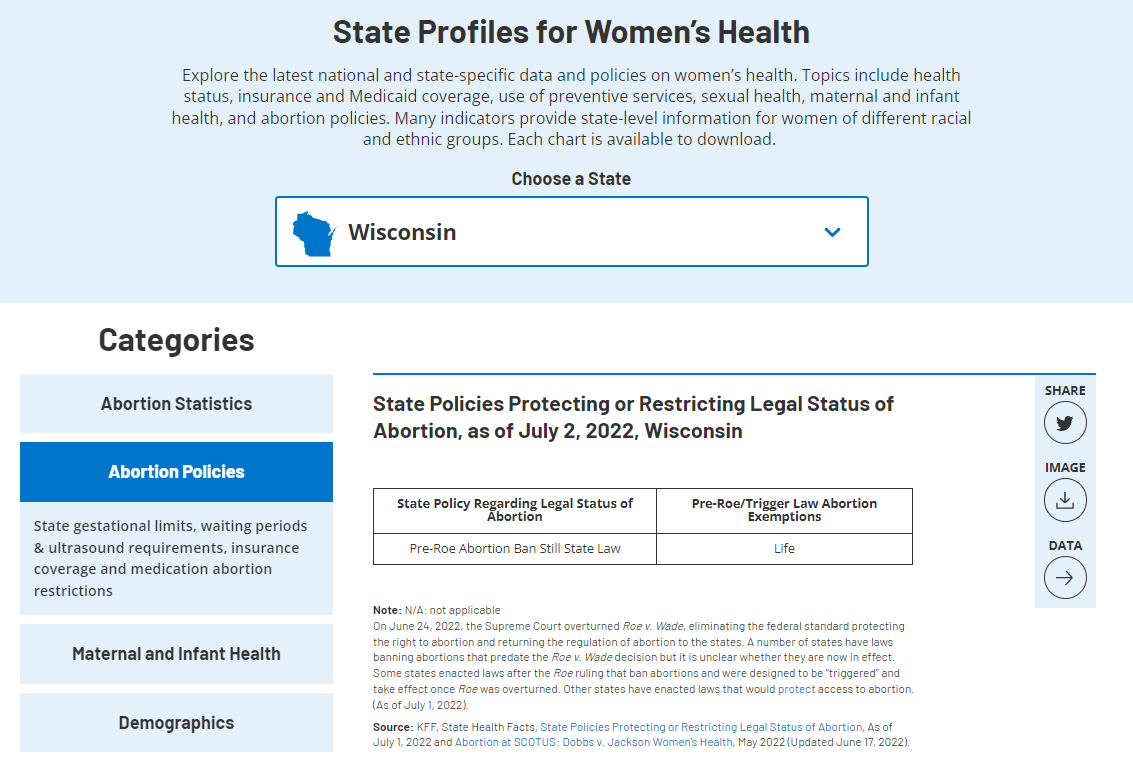Abortion in the United States Dashboard
On June 24, 2022, the Supreme Court overturned Roe v. Wade, eliminating the federal constitutional standard that had protected the right to abortion. Without any federal standard regarding abortion access, states will set their own policies to ban or protect abortion. The Abortion in the United States Dashboard is an ongoing research project tracking state abortion policies and litigation following the overturning of Roe v. Wade. Be sure to click on the buttons or scroll down to see all the content. It will be updated as new information is available.
-
Out-of-Pocket Costs for Abortion Care Among Individuals Enrolled in Employer Sponsored Insurance Plans
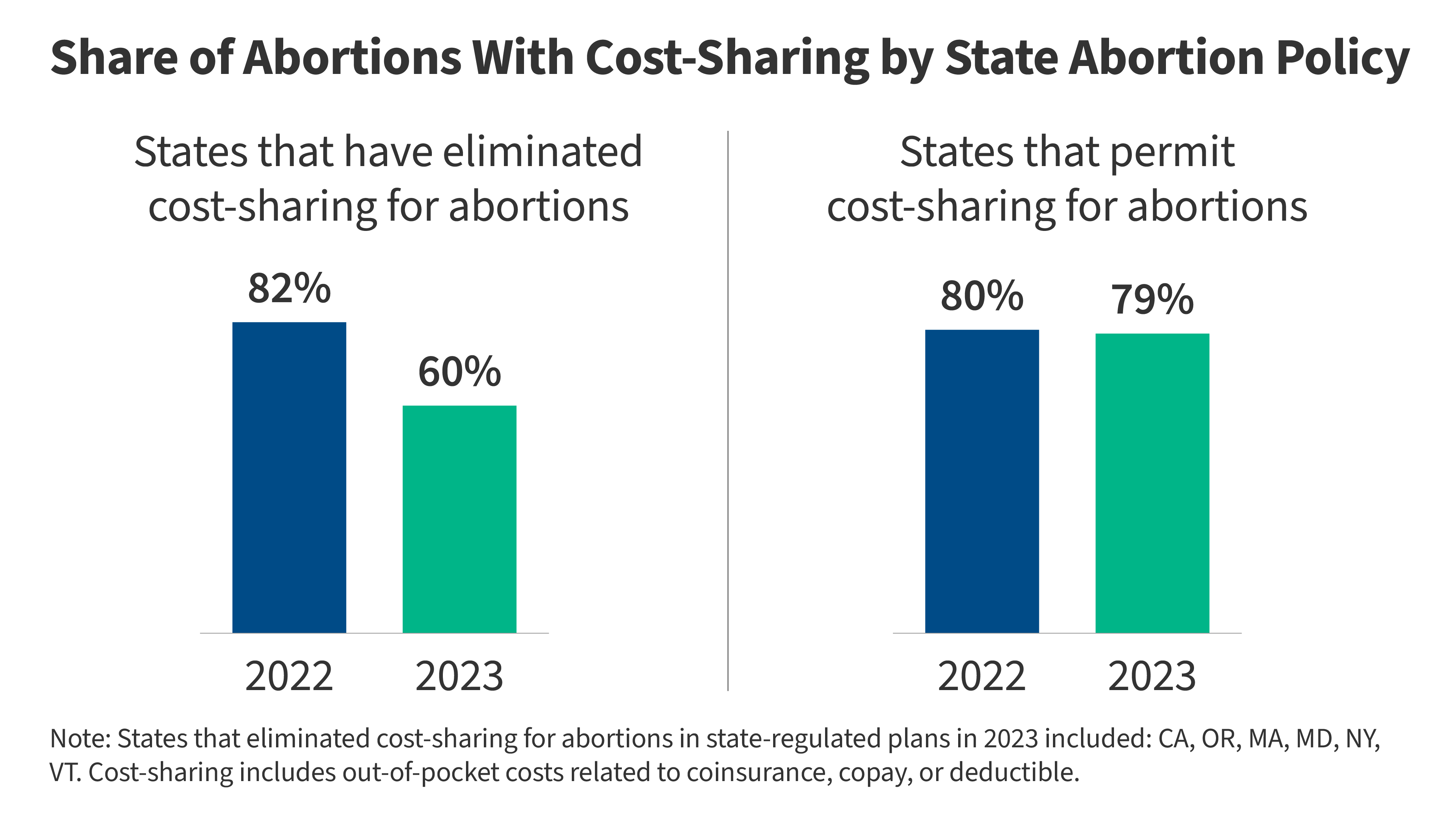
To improve the affordability of abortion services, many states have passed laws that require state-regulated plans to cover the full cost of abortion services for their enrollees. This data note documents the costs associated with abortion care in private plans. Also, KFF analyzes how out of pocket spending has been affected by state laws that require full coverage of abortion services.
-
Classifying Misoprostol and Mifepristone as Controlled Substances: Implications for the Management of Non-Abortion Related Conditions

This data note analyzes employer-sponsored insurance and Medicaid claims data to see how mifepristone and misoprostol—two drugs used in the medication abortion regimen—are prescribed for reasons other than abortion including management of miscarriages, abnormal bleeding or hemorrhage, as well as IUD insertions and other conditions.
-
Criminal Penalties for Physicians in State Abortion Bans
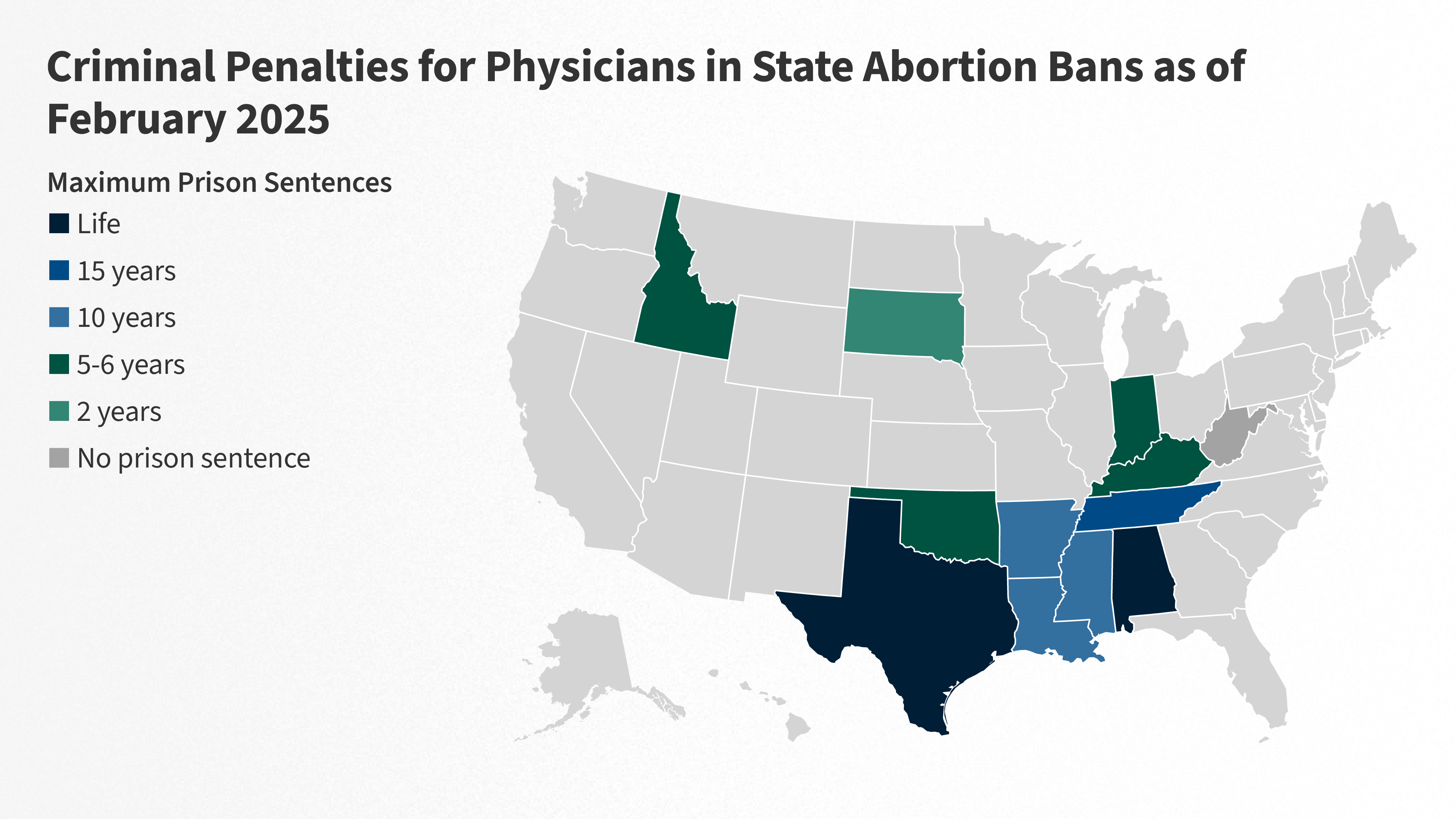
This brief examines the legal considerations for physicians providing abortion care, including criminal and professional penalties, as well as the potential for medical malpractice lawsuits for delayed care to patients due to bans and prosecution for violation of abortion bans across state lines.
-
What’s at Stake for Access to Medication Abortion?

The Supreme Court will be hearing oral arguments for the case FDA v. Alliance for Hippocratic Medicine. This brief explains the issues at stake before the court and their implications for the drug regulatory process and medication abortion access throughout the country.
-
The Comstock Act: Implications for Abortion Care Nationwide

This brief provides background on the Comstock Act, reviews how it has been interpreted by the Biden Administration’s DOJ, and considers how it could be enforced by an administration that is hostile toward abortion to severely restrict the distribution of drugs and supplies used for abortion, with implications for abortion access in all states across the country.
-
Emergency Abortion Care to Preserve the Health of Pregnant People: SCOTUS, EMTALA, and Beyond

This policy watch outlines SCOTUS’ June 27, 2024, decision dismissing the case, Moyle v. United States, where the Court had been asked to determine if a federal law called the Emergency Medical Treatment and Labor Act preempted Idaho’s abortion ban. The decision returns the case to the lower courts and reinstates a court order blocking enforcement of the Idaho ban where it prohibits abortion care for pregnant people having medical emergencies.
-
A Closer Look at Rape and Incest Exceptions in States with Abortion Bans and Early Gestational Restrictions
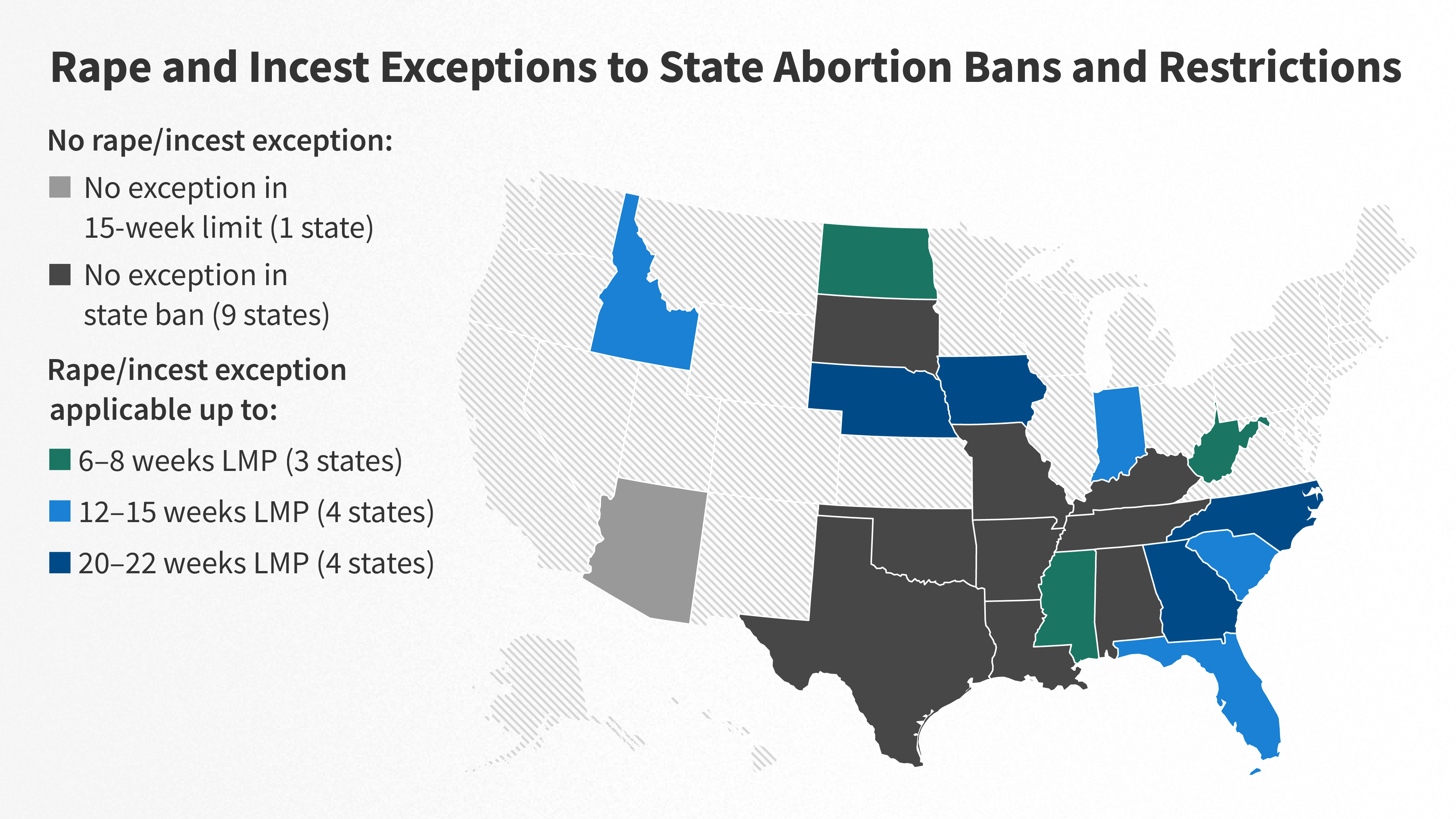
Ten of the 21 states with abortion bans or gestational limits do not have an exception for pregnancies resulting from sexual assault. In the 11 states with rape and incest exceptions, the details and fine print make can make access to abortion care unattainable for pregnant survivors of sexual assault. Law enforcement reporting requirements, early pregnancy gestational limits, and the lack of provider availability present major barriers to abortion access, even when the state has an exception.
-
Reproductive Rights and Abortion Litigation Tracker
This State and Federal Reproductive Rights Litigation tracker aggregates information about ongoing litigation regarding abortion bans and restrictions, FDA approval of Mifepristone (an abortion pill) and other federal regulations.
-
Criminal Penalties for Physicians in State Abortion Bans

This brief examines the legal considerations for physicians providing abortion care, including criminal and professional penalties, as well as the potential for medical malpractice lawsuits for delayed care to patients due to bans and prosecution for violation of abortion bans across state lines.
-
Who Decides When a Patient Qualifies for an Abortion Ban Exception?
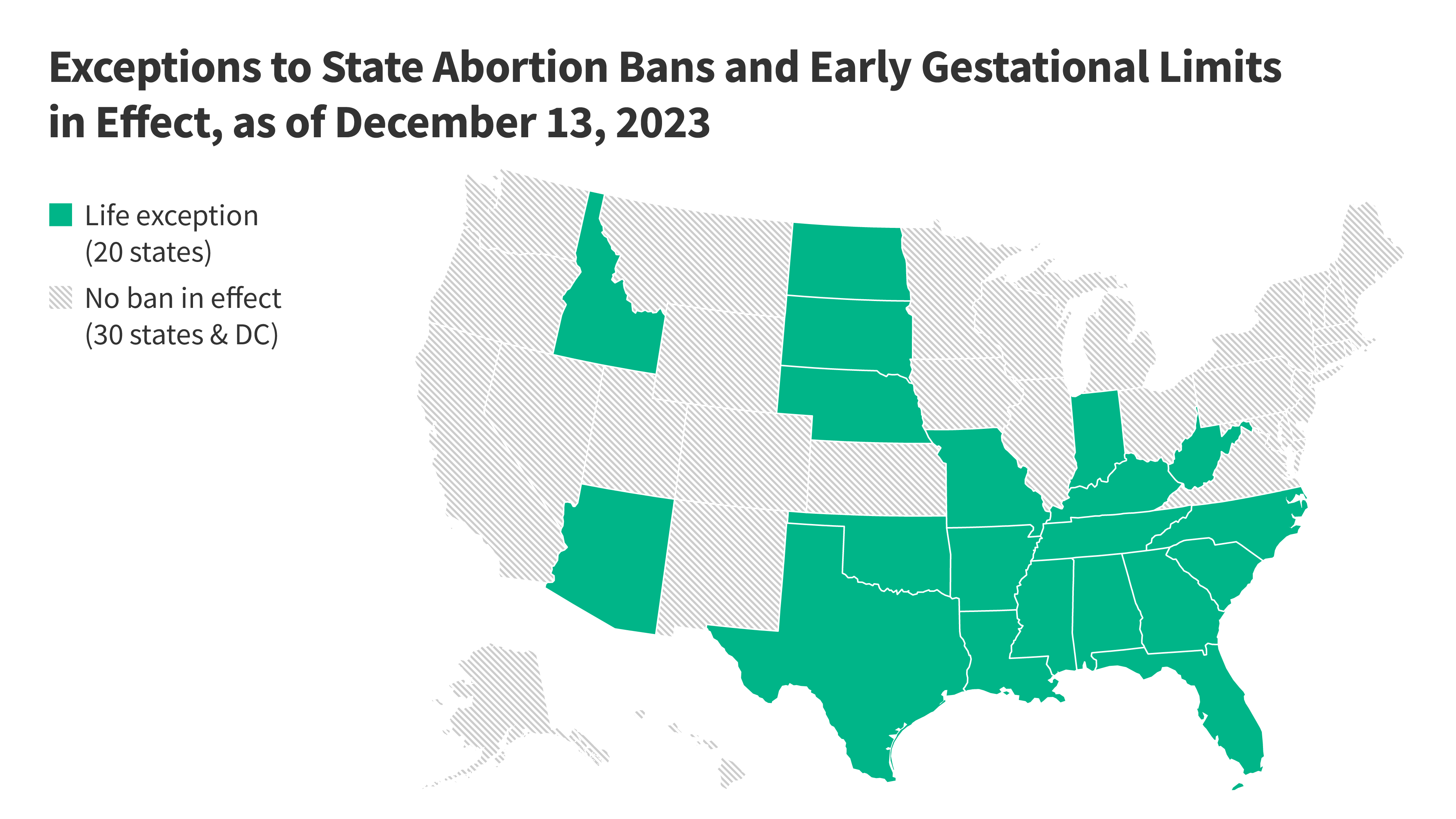
While all eyes were on Texas and the recent case of Kate Cox, a woman seeking a court order allowing her abortion under an exception to the Texas abortion ban, the conflict could have played out in many states. The risk to doctors is so high that many doctors are hesitant to provide life-saving abortion care unless the threat to life is imminent.
-
Abortions Later in Pregnancy in a Post-Dobbs Era

This brief explains why individuals may seek abortions later in pregnancy, how often these procedures occur, and the various laws which regulate access to abortions later in pregnancy across the country.
-
What’s Next for State Abortion Ballot Initiatives?
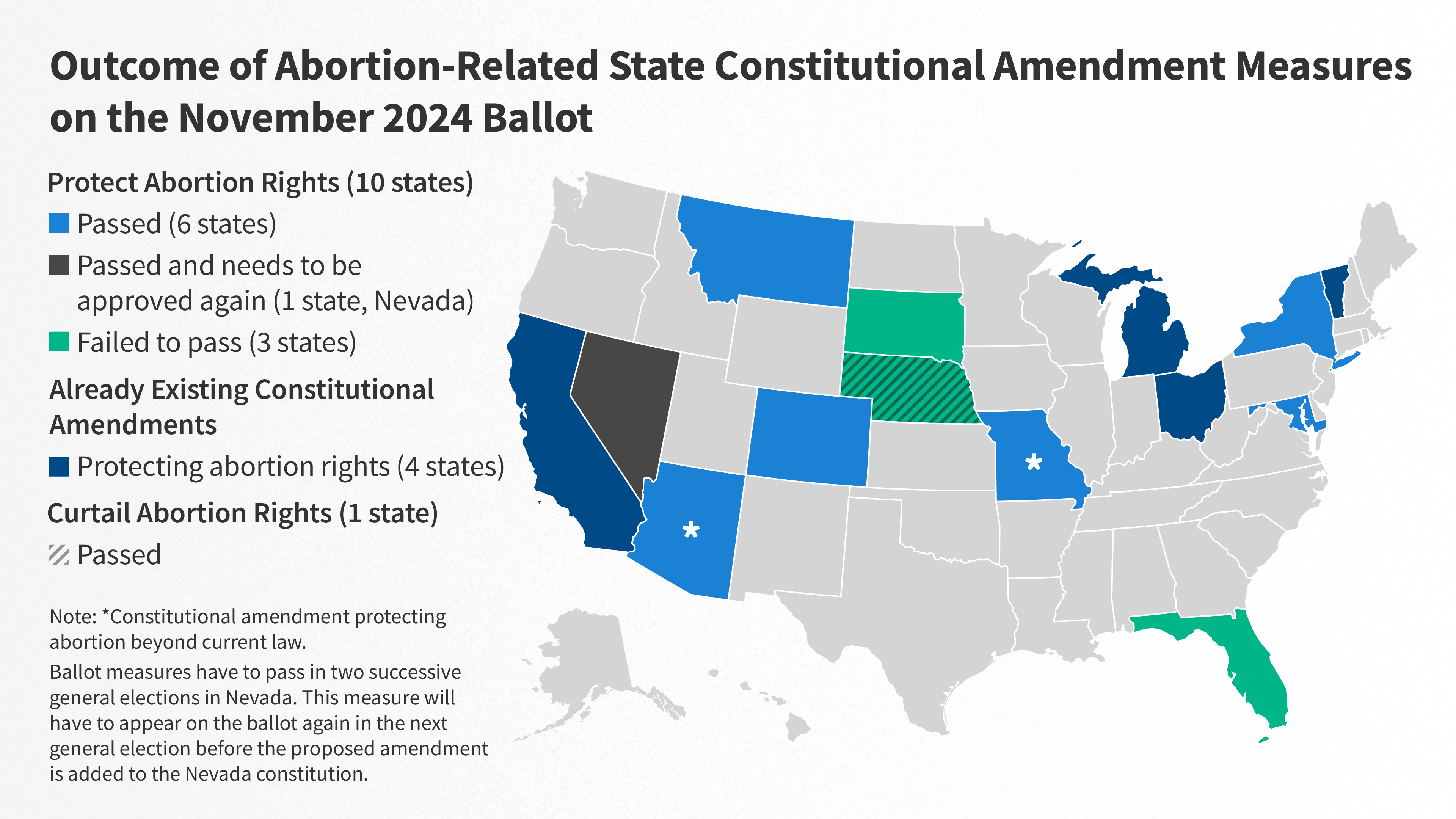
This brief examines what the November election and prior efforts to enshrine abortion rights at the ballot box mean for those states and what’s next, including the future of abortion restrictions in states where voters enshrined abortion rights where abortion was banned or restricted, as well as those that do not have abortion bans.
-
The Opportunities and Realities of Citizen-Initiated State Ballot Abortion Measures

Presidential candidate Trump claims credit for SCOTUS’ Dobbs decision and says that as a result, the “states are voting.” States are making decisions on abortion policy, but it’s mostly been state legislatures, not voters. Few states with abortion bans have a process for citizen-initiated constitutional amendments. In those states, lawmakers and anti-abortion activists have attempted to block abortion measures from qualifying for the ballot or put roadblocks in their place.
-
Key Facts About Abortion in the United States
Over four in ten (45%) abortions occur by six weeks of gestation, 36% are between seven and nine weeks, and 13% at 10-13 weeks. Just 7% of abortions occur after the first trimester.
-
Abortion Trends Before and After Dobbs
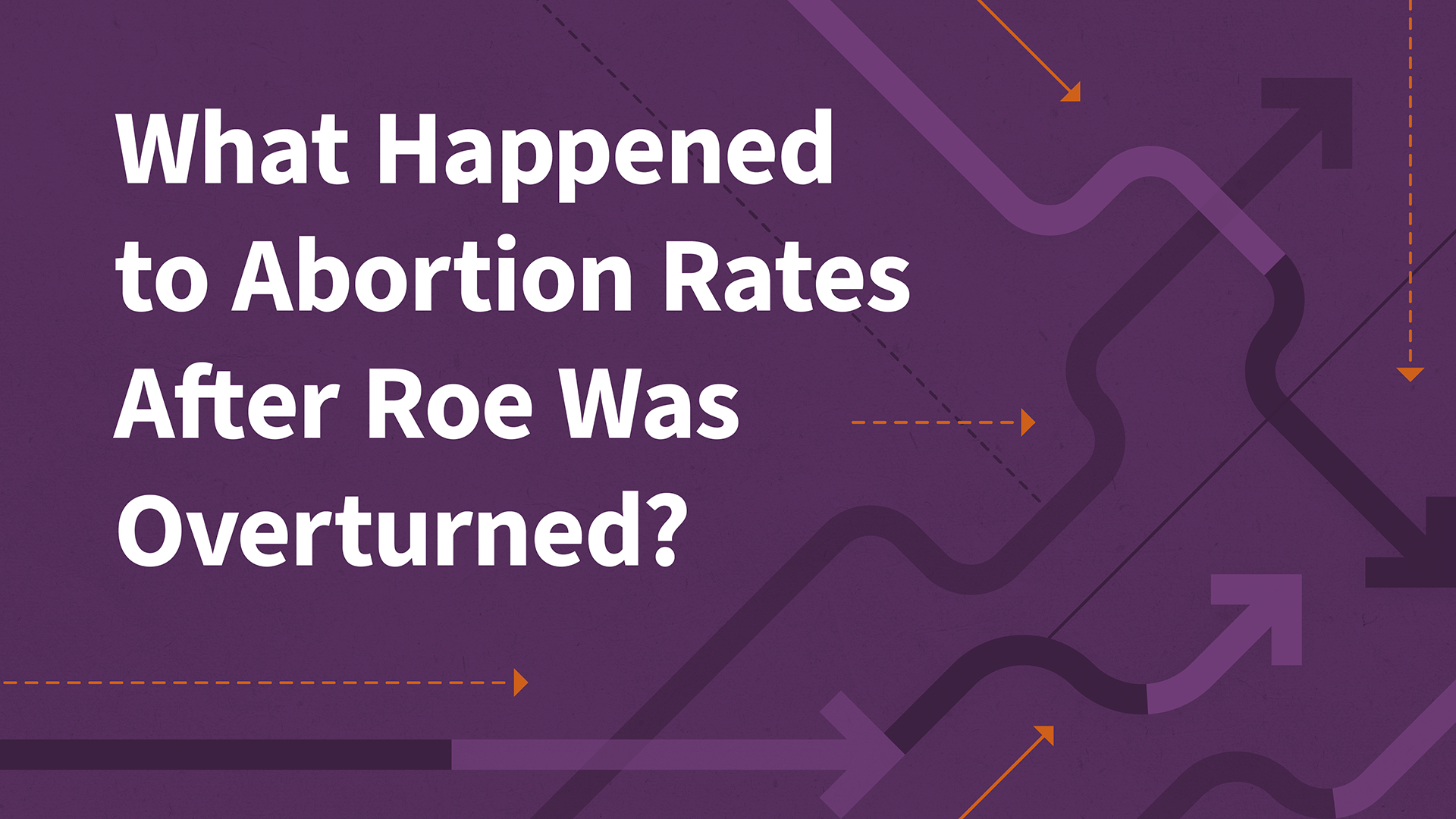
This brief reviews the different sources of abortion data in the United States, the factors that have affected abortion rates across the U.S, before and after Roe v. Wade, and what we may see as the Trump administration, Republican majorities in the House and Senate, and a conservative federal judiciary shape policy in the coming years.
-
Telehealth Availability
As part of efforts to limit abortion access, some states have taken action to block the use of telehealth for abortion. Among the 36 states & DC that have not banned abortion, eleven states have at least one restriction that requires at least one trip to the clinic, and effectively ban telehealth for medication abortion
-
The Availability and Use of Medication Abortion
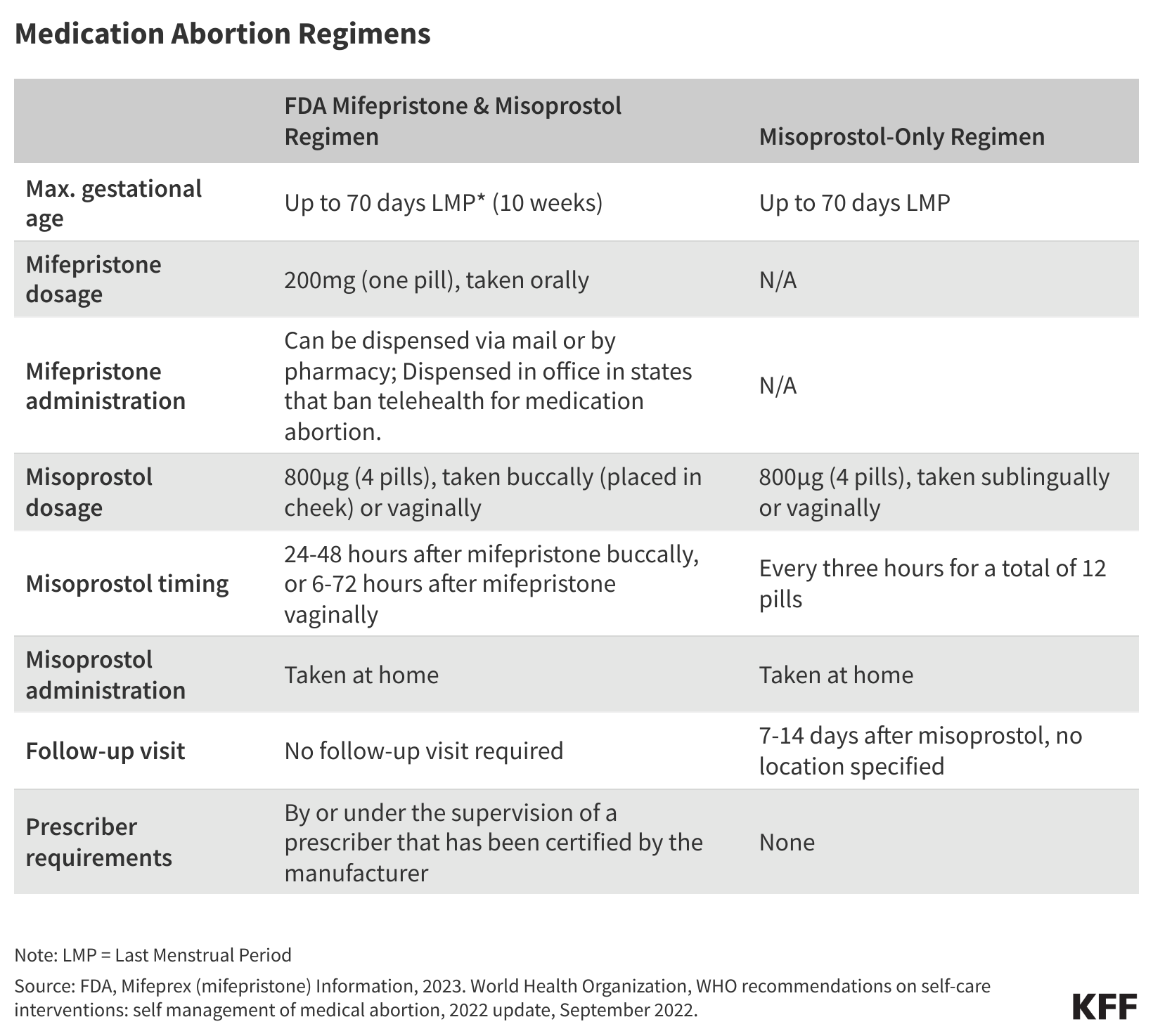
This factsheet provides an overview of medication abortion, with a focus on federal and state regulations pertaining to its provision and coverage, and the role of the drug in self-managed abortions.
-
How State Policies Shape Access to Abortion Coverage
Several states have enacted private plan restrictions and have also banned abortion coverage from ACA Marketplace plans. Currently, there are 10 states that restrict abortion coverage in private plans and 25 that ban coverage in any Marketplace plans.
-
Abortion Decision Renews Questions About Employer Access to Health Information

This Policy Watch takes a look at employers ability to access abortion information when their health plan covers abortion services. With some states criminalizing entities who assist in abortions, employers and providers face legal jeopardy and existing privacy laws such as HIPAA (the Health Insurance Portability and Accountability Act) may be limited in their privacy protections.
-
Variability in Payment Rates for Abortion Services Under Medicaid
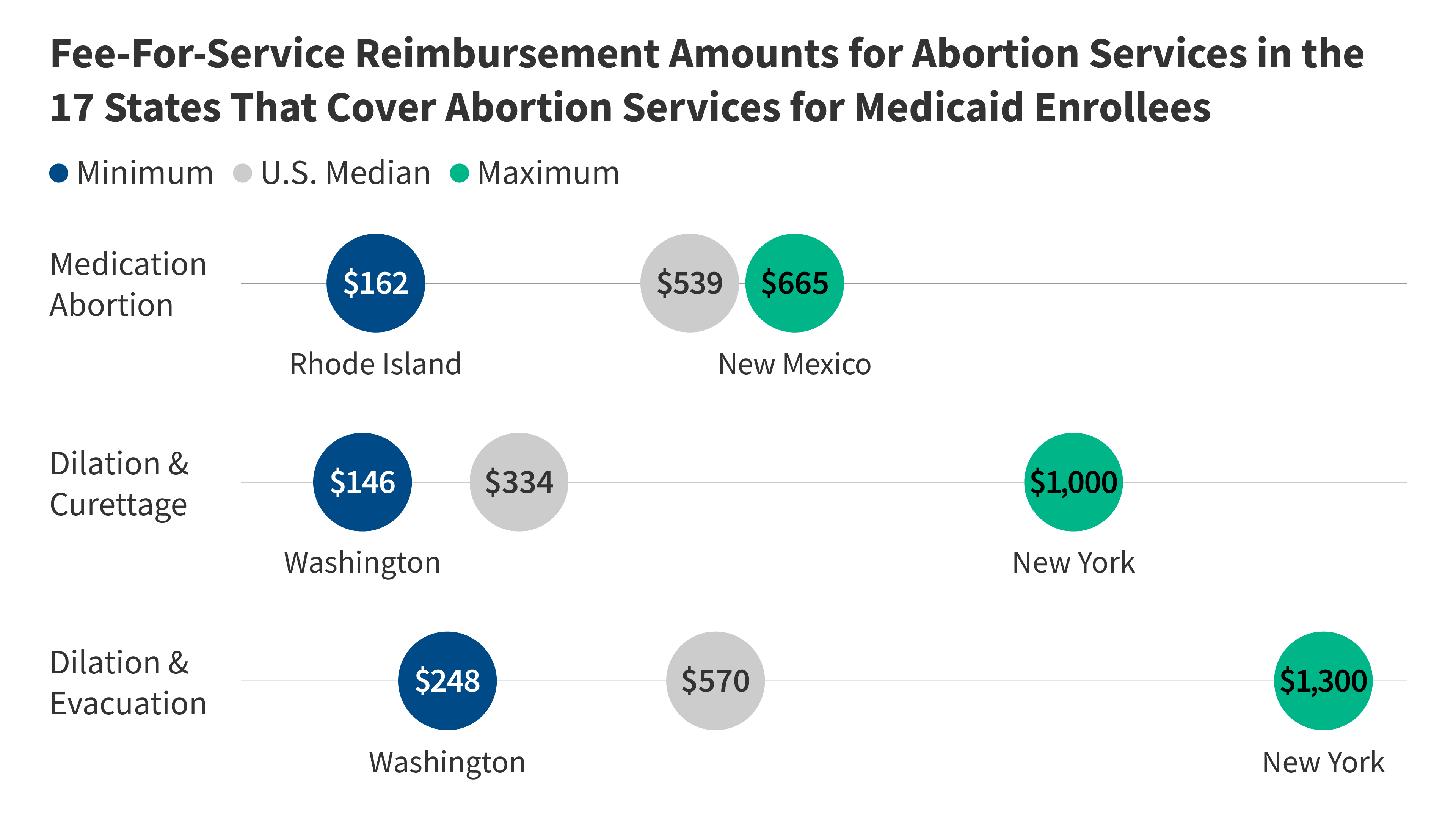
This brief looks at Medicaid reimbursement rates for abortion services across states, including D&C and D&E procedures, and medication abortion. There is tremendous variability in how much states reimburse for abortion services.
-
The Hyde Amendment and Coverage for Abortion Services Under Medicaid in the Post-Roe Era
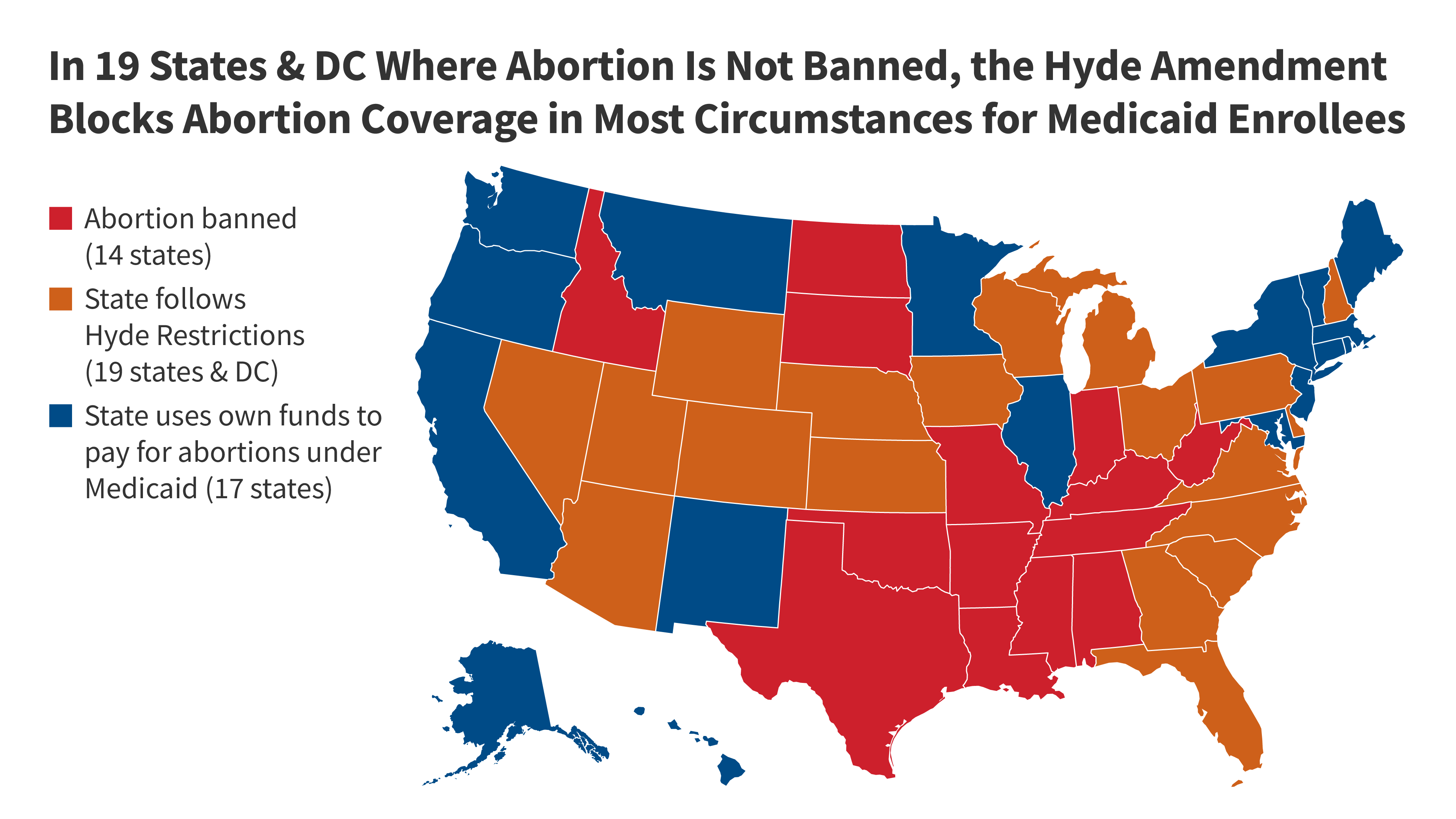
This brief details the federal programs that are affected by the Hyde Amendment and laws and regulations that have a similar goal, provides estimates on the share of women insured by Medicaid affected by the law, reviews the impact of the law on their access to abortion services, and discusses the potential effect if the law were to be repealed.
-
Employer Assistance with Abortion Related Travel Costs
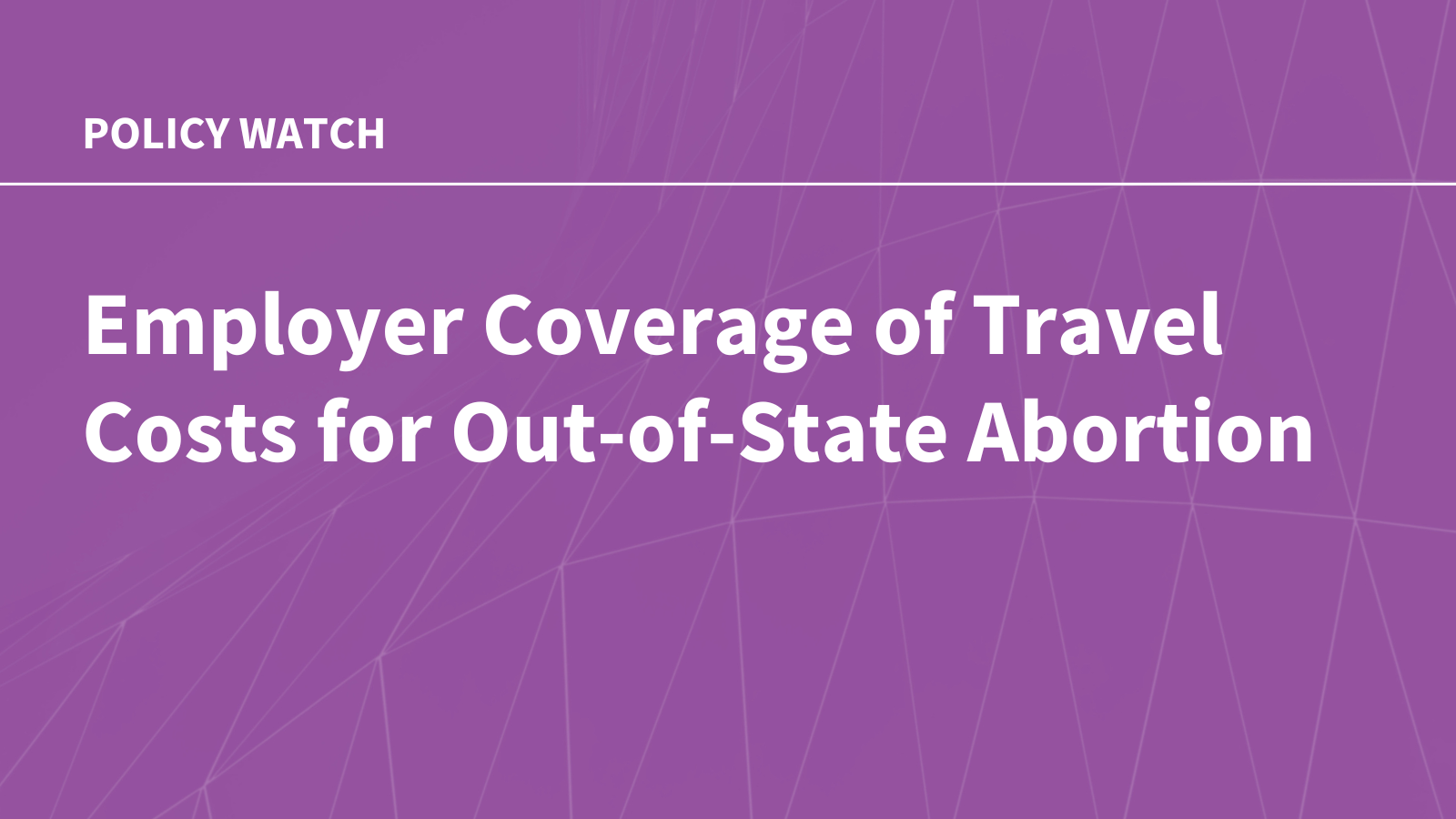
This Policy Watch gives an overview of employers offering to cover travel expenses for workers who need to go out of state for an abortion in the context of increasing restrictions on abortion around the country. We discuss who is offering these benefits, the implications for workers, and some of the legal and political concerns for employers.
-
Coverage of Abortion in Large Employer-Sponsored Plans in 2023
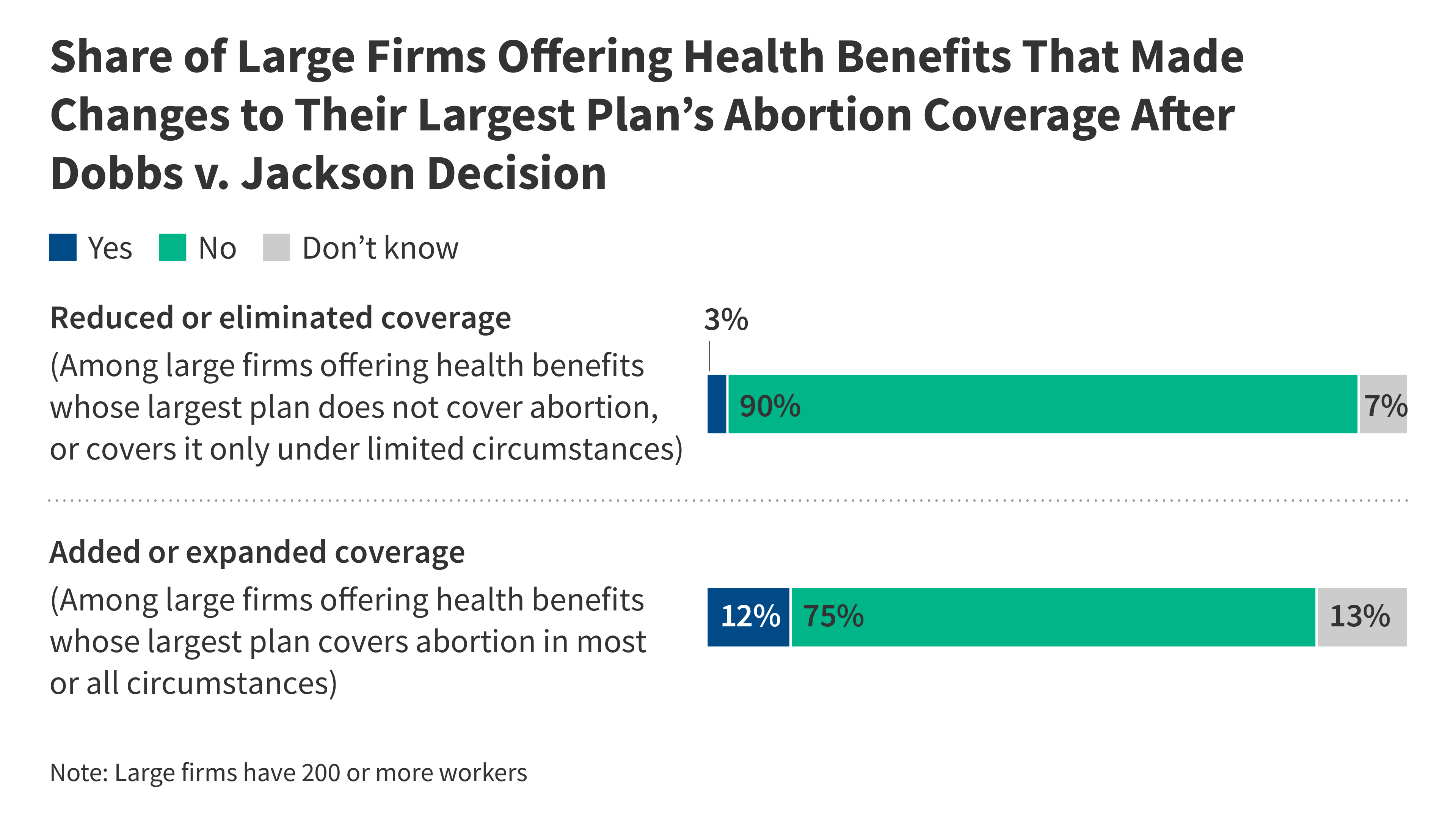
This brief presents findings from the 2023 KFF Employer Health Benefits Survey on coverage of abortion services in large employer-sponsored health plans, changes employers made to abortion coverage since the 2022 Supreme Court ruling, and employers’ provision of financial assistance for travel out of state to obtain an abortion.
-
KFF Health Tracking Poll March 2024: Abortion in the 2024 Election and Beyond
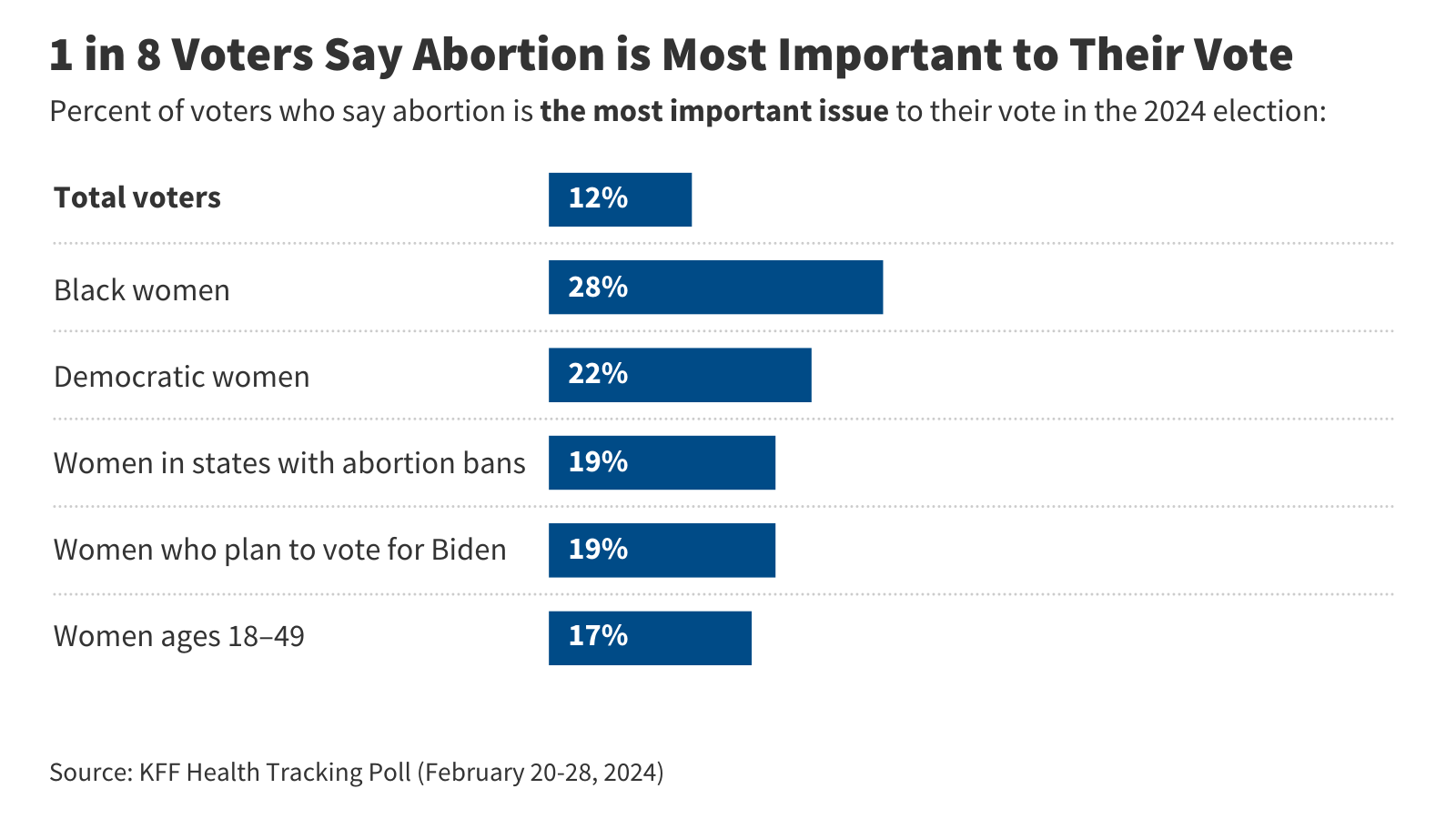
This poll finds 1 in 8 voters say abortion is the most important issue to their vote. They are younger, lean Democratic, and generally want abortion to be legal in all or most cases. The poll also gauges the public’s views on abortion-related policies, including a national 16-week abortion ban and allowing abortion for pregnancy-related emergencies.
-
Women’s Views of Abortion Access and Policies in the Dobbs Era: Insights From the KFF Health Tracking Poll
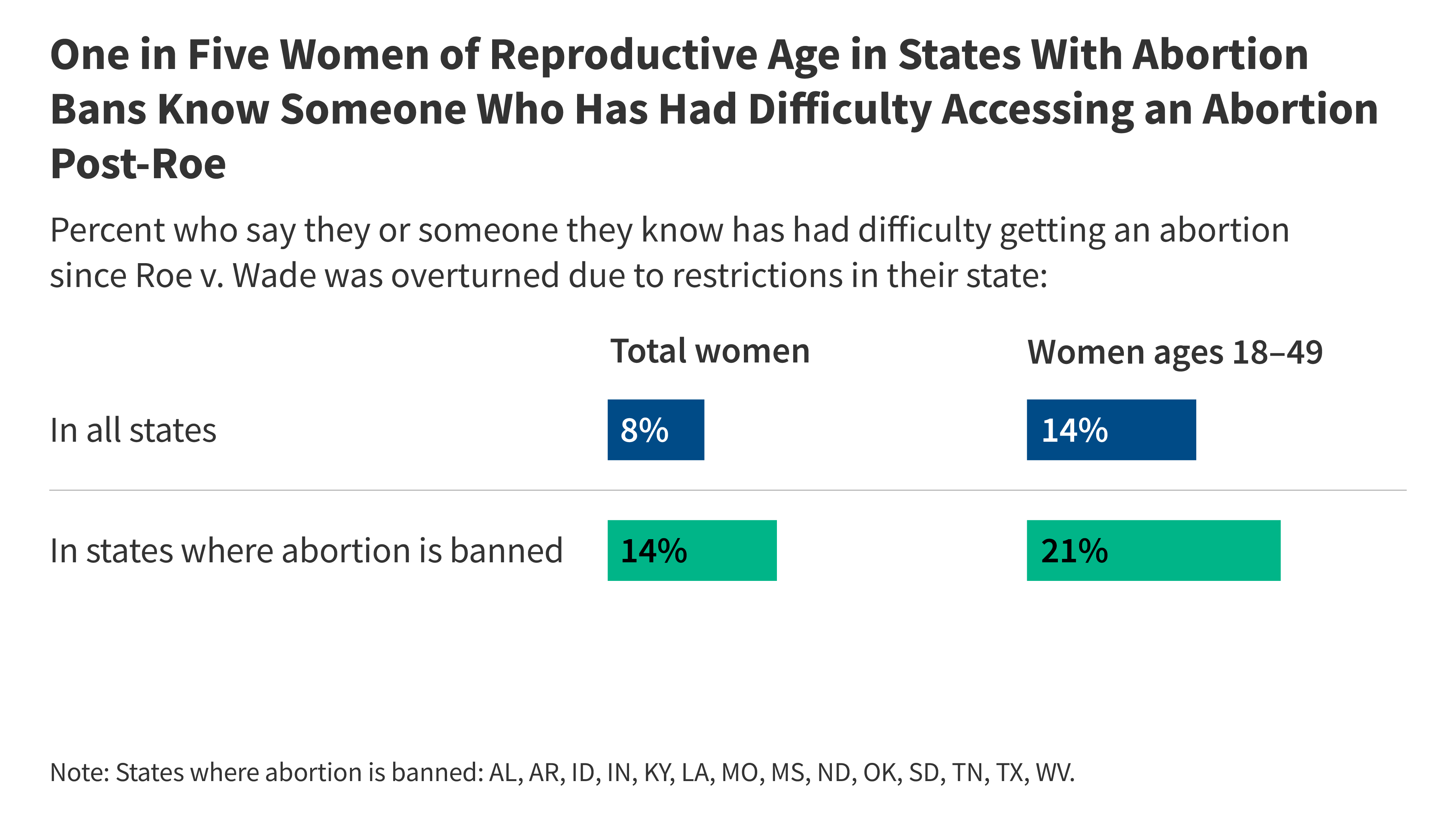
Our latest poll finds one in five women of reproductive age in states with abortion bans say either they or someone they personally know has had difficulty obtaining an abortion. Majorities of women across states—including in those with abortion bans—think abortion should be legal in all or most cases and support a range of policies that protect abortion access.
-
Abortion Experiences, Knowledge, and Attitudes Among Women in the U.S.
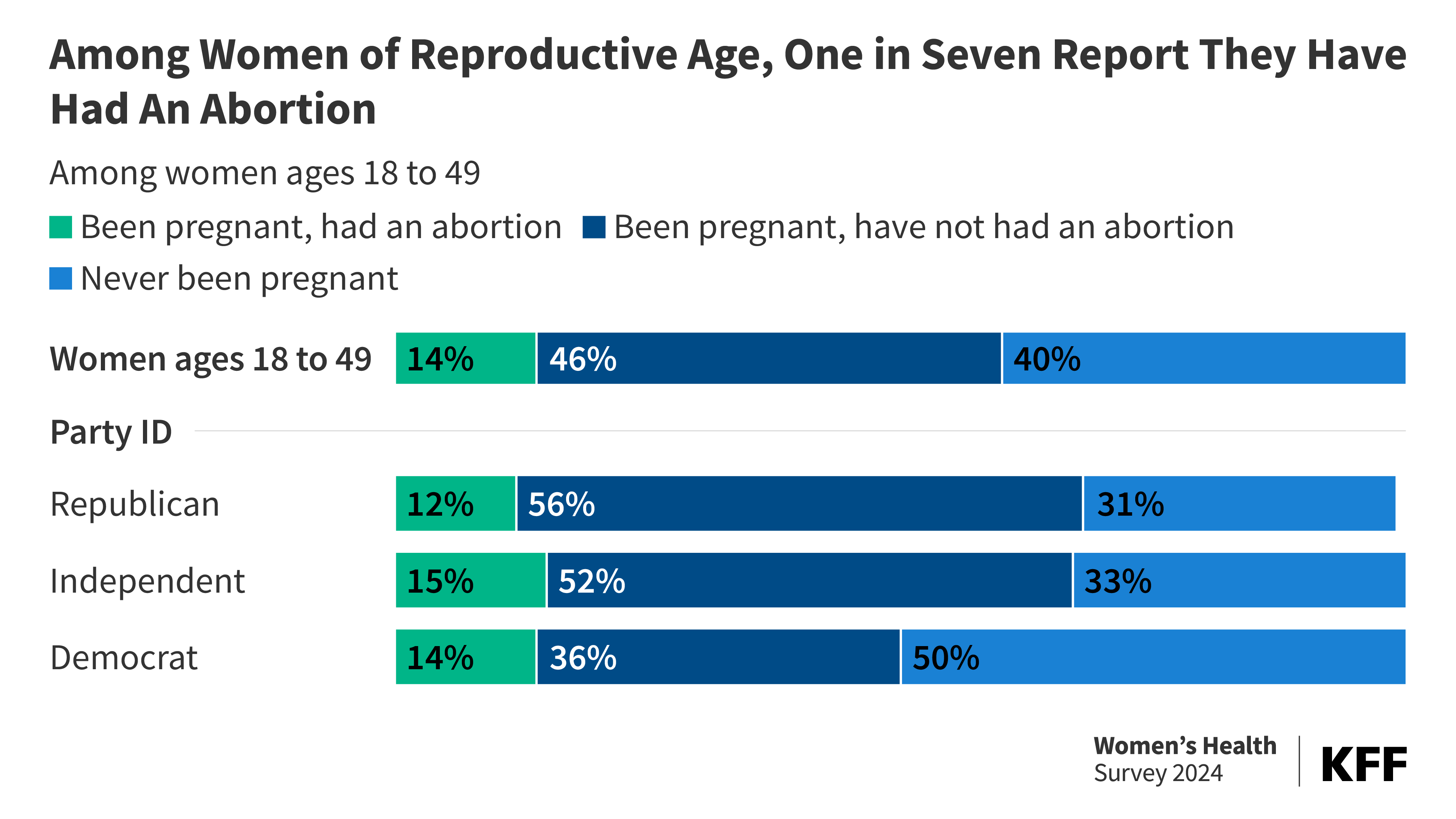
This brief provides new information from the 2024 KFF Women’s Health Survey about women’s experiences with abortion, the fallout of overturning Roe v. Wade, women’s knowledge about abortion laws in their states including medication abortion, as well as their opinions on the legality of abortion.
-
Women and Abortion in Florida

This brief provides information about abortion experiences, awareness, and attitudes of Florida women ages 18 to 49, based on findings from the 2024 KFF Women’s Health Survey, a nationally representative survey on health care issues.
-
Women and Abortion in Arizona
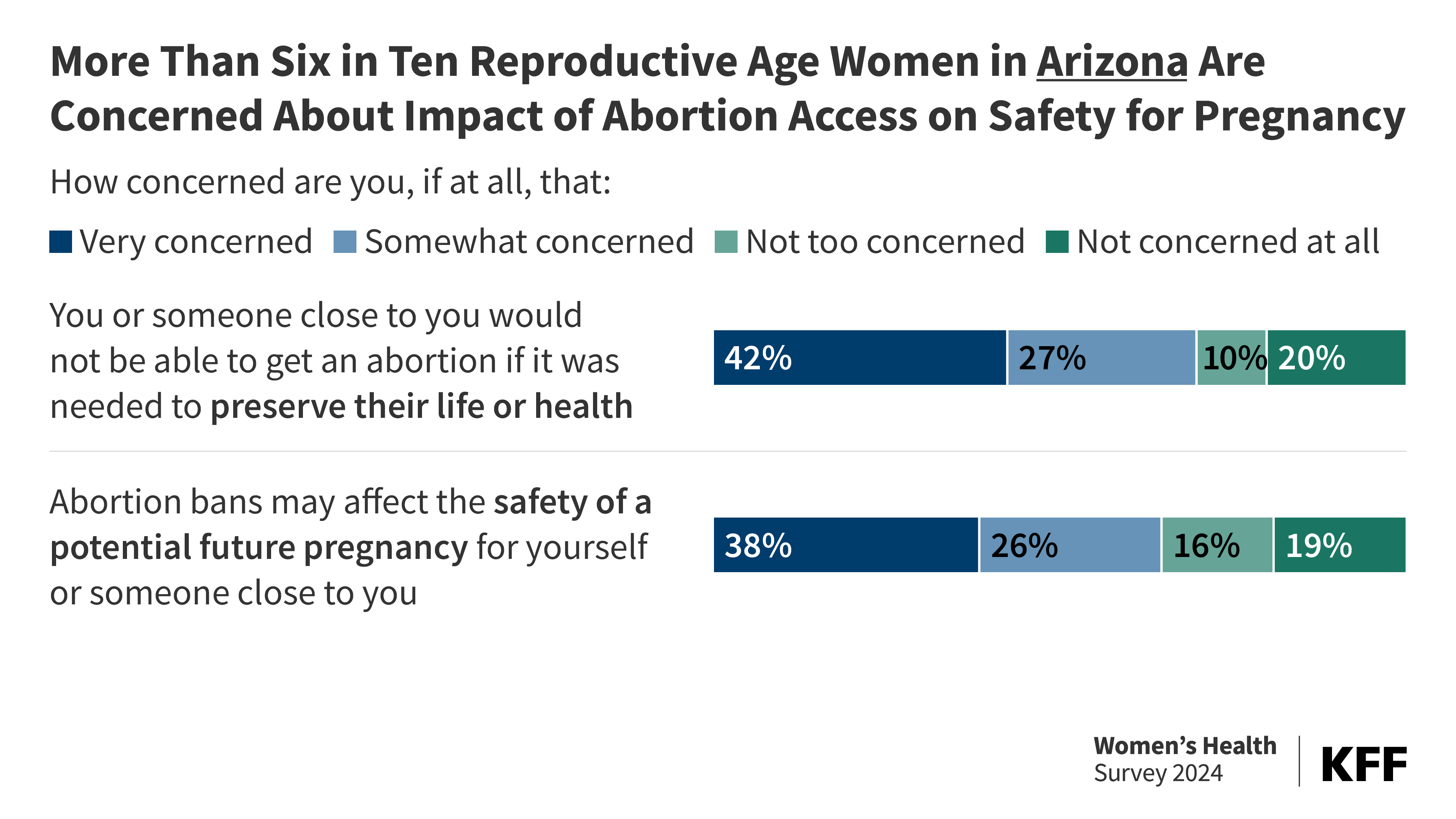
This brief provides information about abortion experiences, awareness, and attitudes of Arizona women ages 18 to 49, based on findings from the 2024 KFF Women’s Health Survey, a nationally representative survey on health care issues.
-
Pregnancy-Related Mortality (per 100,000 births) by Race and Ethnicity, 2017-2019
Native Hawaiian or Pacific Islander, American Indian or Alaskan Native and Black people are more likely to die while pregnant or within a year of the end of pregnancy compared to White people
-
State Abortion Policies by Race and Ethnicity Among Women Ages 18-49, 2022
Six in ten of Black (60%) and AIAN (59%) women ages 18-49 live in states with abortion bans or restrictions. Just over half (53%) of White women ages 18-49 live in states with bans or restrictions, while less than half of Hispanic (45%) and about three in ten Asian (28%) and NHPI (29%) women ages 18-49 live in these states
-
Dobbs-era Abortion Bans and Restrictions: Early Insights about Implications for Pregnancy Loss
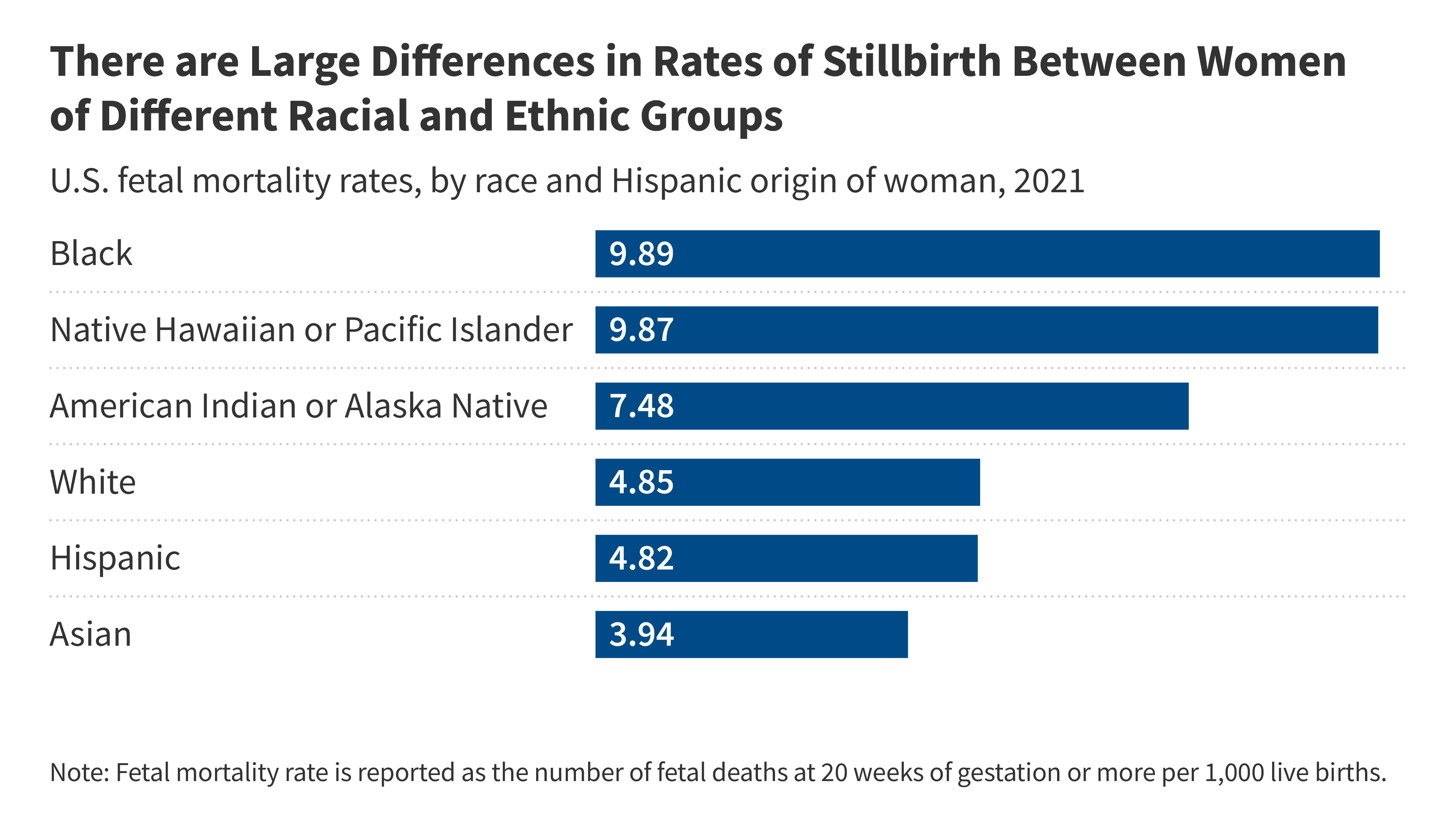
This brief examines pregnancy loss management in the Dobbs era and explores how limiting or banning abortion may have negative consequences on people experiencing miscarriage or stillbirth.
-
A National Survey of OBGYNs’ Experiences After Dobbs
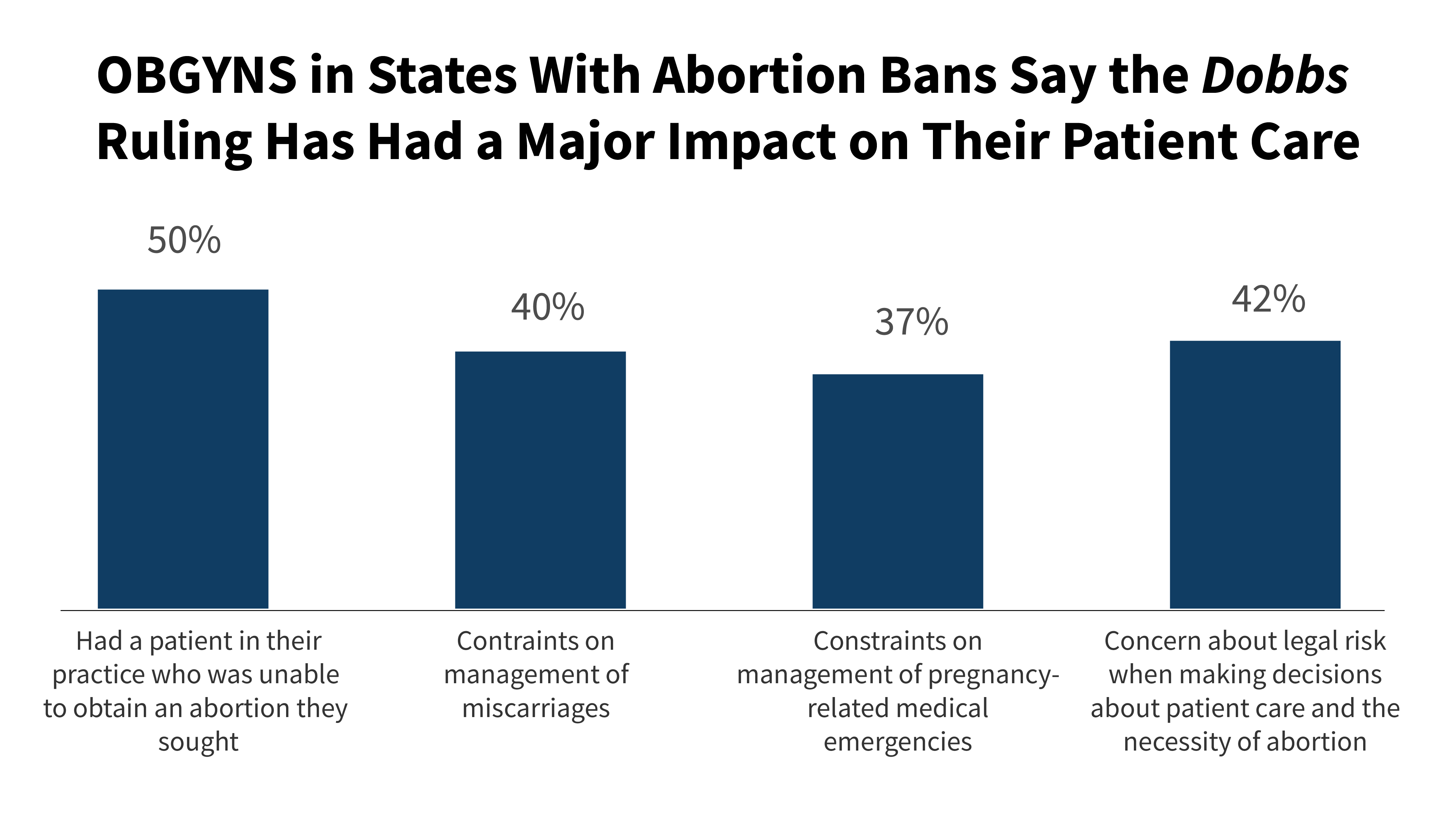
This report, based on a nationally representative survey of office-based OBGYNs practicing in the United States, examines the provision of sexual and reproductive health care provided by OBGYNs before and after the Dobbs decision, comparing the experiences of OBGYNs practicing in states where abortion is fully banned, states with gestational restrictions, and states where abortion remains available under most circumstances.
Latest Resources From KFF
-

Key Facts on Abortion in the United States
-

Abortion Trends Before and After Dobbs
-

States Expand Access to Ivermectin as Cancer Myths Continue, and Abortion Pill Faces False Water Supply Claim — The Monitor
-

10 Key Data Points About the Experiences of LGBT+ Women and Their Access to Care
-

SCOTUS Ruling on Medina v. Planned Parenthood Will Limit Access to Care for Patients in South Carolina and Beyond
-

Flawed Report Aims to Undercut Established Research on Abortion Pill Safety, Plus How a Federal Initiative to Study Autism May Overemphasize Environmental Toxins — The Monitor

